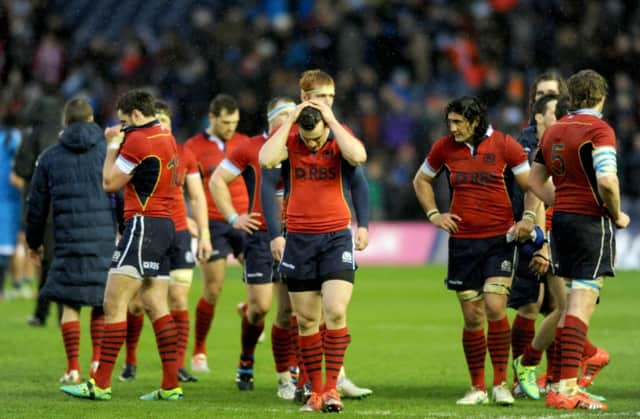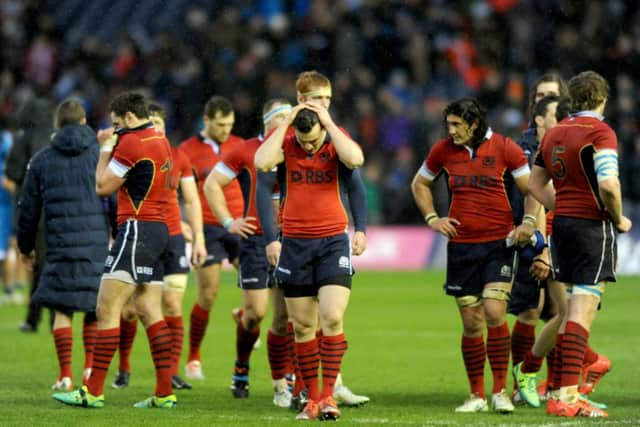Iain Morrison: Scotland miss craft of Finn Russell


Scotland have now played their “easier” opposition, with England and Ireland still to come and nothing those two saw on Saturday will keep them awake at night. Scotland were bullied up front, toothless in attack and naive throughout.
Once again indiscipline played a big part in Scotland’s downfall. Not so much the yellow cards at the end – they were arguably a cynical necessity – but the penalty on the halfway mark that allowed Italy to resume their siege of the Scotland line was brainless like so much of Scotland’s play.
Advertisement
Hide AdAdvertisement
Hide AdThe root of their problems stemmed from the set piece. Italy’s original attacking lineout on 72 minutes at the start of that eight-minute siege came from a scrum penalty. The scrum was awarded because Fraser Brown threw squint at a lineout but why a brand-new hooker only recently joined the fray was asked to ping his very first throw to the tail is a question Vern Cotter may well put to Jonny Gray.


FOLLOW US
SCOTSMAN TABLET AND MOBILE APPS
You could also argue that the Scots should have contested the Italian lineout that took place 24 metres from the home try-line with about three minutes remaining. The home team knew that trouble was on its way if Italy set up their driving maul, so why not throw some bodies into the air and contest the throw in an attempt to solve the problem at source?
As ever, many of these issues stem from the fact that Scotland’s player pool is more of a player puddle. It’s depth is measured in millilitres rather than fathoms. If everyone is fit and healthy, then the Scots are competitive, as they were against New Zealand in November. When they are missing key personnel, then things start to unravel pretty quickly.
In the absence of Richie Gray, Grant Gilchrist, Adam Ashe, David Denton and Jim Hamilton, the Scottish squad was short of beef, which has implications not only for defending the maul, but also at the set scrum. Moreover, the lack of big, bruising ball carriers meant that the Scots’ attack was all too often too lateral. You have to earn the right to go wide and they didn’t.
In the absence of Sean Maitland, Sean Lamont is finally beginning to show the miles on his clock. That forward pass to Stuart Hogg around the one-hour mark was unnecessary, given that Blair Cowan was running a good support line from deep. A pop to the flanker probably wouldn’t have resulted in an immediate try but nor would it have offered Italy an easy exit.
But the man Scotland missed most of all was stand-off Finn Russell because, without, him an exciting set of backs that has looked creative and sharp to date were almost anonymous. The Scottish quick men managed six clean line breaks against both France and Wales but, on Saturday against an Italian defence that has already conceded eight tries in the opening two matches, the Scots managed just four clean breaks and failed to construct a single try; Mark Bennett’s early interception was an individual poacher’s effort.
While France and Wales both employ a blitz defence, Italy use a hybrid model that rushes up early when the defenders are set in their starting blocks but reverts to an old fashioned drift defence as the attack builds momentum and the defenders are on their heels rather than their toes.
Peter Horne plays deep and likes to play out the back, he even said as much ahead of this game. What he means is that he ignores the decoy runners coming from out-to-in and, instead, passes the ball “out the back” (behind them) to the attackers running in-to-out from deep. The ploy is overdone. It can work but only when those decoy runners get the ball occasionally to halt the opposition drift and they rarely if ever did against Italy, who were able to shuffle out early and smother the Scottish attack in the wide channels.
Advertisement
Hide AdAdvertisement
Hide AdSomething was obviously said at half time because both Scotland’s halfbacks, Horne and Greig Laidlaw, attacked the line a lot better in the second 40 and with some joy, but the almost telepathic understanding that midfielders get from playing regularly with one another simply wasn’t there. No one anticipated Horne’s little darts or, if they did, he was swallowed up by the blue shirts before he could get the offload away.
Fifteen minutes into Scotland’s match against Wales, Russell spotted he is up against Dan Lydiate, he takes the outside line and draws the tackle from the flanker and centre Jamie Roberts, before putting Dunbar through the gap. Cotter will beef up the pack as best he can – Adam Ashe, Jim Hamilton and David Denton will get mentioned in selection – but if Scotland’s quick men are to do any damage at Twickenham then Russell will surely resume his playmaker’s role.